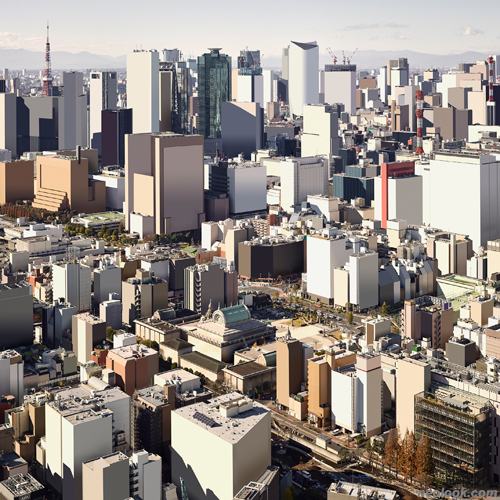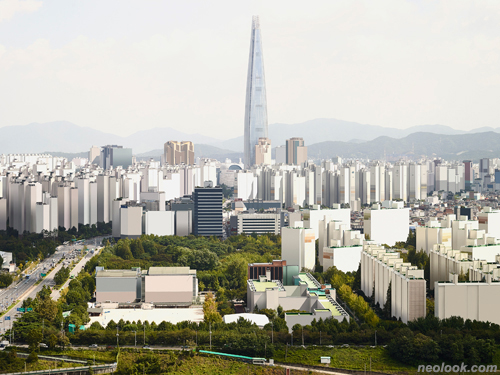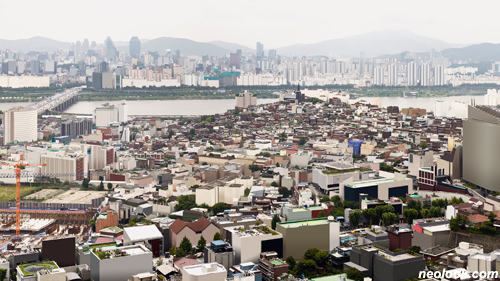- ● homepage
- ● archives
- ● restoration
- ● books
- ● big banners
- ● post board
- ■ neo's search
- ■ about us
- ■ 게재방법 안내
- 개인정보처리방침

- [email protected]
- Tel. 02_335_7922
- Fax. 02_335_7929
- 10:00am~04:30pm
- 월요일~금요일
- 3/3(월) 대체공휴일

We built this City 우리가 만든 도시
박찬민展 / PARKCHANMIN / 朴贊珉 / photography 2021_1001 ▶ 2021_1024 / 월요일 휴관
● 위 이미지를 클릭하면 네오룩 아카이브 Vol.20151208b | 박찬민展으로 갑니다.
별도의 초대일시가 없습니다.
관람시간 / 12:00pm~06:00pm / 월요일 휴관
갤러리 진선 GALLERY JINSUN 서울 종로구 삼청로 59 2층 Tel. +82.(0)2.723.3340 www.galleryjinsun.com
무수한 반복이 만드는 섬세한 차이 ● 1989년 해외여행이 전면 자유화되기 이전 학생들이 세계 건축을 접할 방법은 글과 흑백사진뿐이었다. 몇몇 여행가들이 낸 세계여행 컬러 화보집이 해외 도시의 풍경을 접하는 최고의 통로였다. 그때 해외에서 공부하고 돌아온 젊은 교수들이 보여준 거장 건축가들의 작품은 가슴을 뛰게 했었다. 교수연구실 책장에 꽂혀있었던 슬라이드 파일은 학술적 권위를 의미했다. 1990년대 들어서서 건축가들은 그룹을 지어 건축을 탐방하러 해외로 나갔다. 어깨는 무거운 카메라가 걸려있었고, 배낭에는 수십에서 수백 통의 슬라이드 필름이 들어있었다. ● 그로부터 30년이 지난 지금, 새로운 여행지에서 카메라를 꺼내는 건축가는 별로 없다. 스마트폰으로 스냅 사진을 찍는 것이 전부다. 정년을 앞둔 선배 교수연구실에서 미처 스캔하지 못한 수천 장의 이미지들이 슬라이드 파일 채로 쓰레기통으로 버려지는 것을 본다. 국내외 할 것 없이 마찬가지다. 슬라이드든 디지털 파일이든 이미지를 소장하고 있다는 것이 더는 권위가 아니다. 엄청난 양의 이미지가 인터넷을 통하여 유포되고 있다. 아프리카와 남미에서 준공된 신작 도면과 이미지를 담은 웹진이 매일 스마트폰을 통해 배달된다. 차단하려고 마음을 먹지 않는 이상 이미지와 정보는 우리의 일상을 에워싸고 있다. ● 나는 도면, 역사 기록, 통계를 재료로 삼아 도시와 건축을 공부하고 있다. 하지만 분석적 연구보다 직관적으로 포착한 사진 한 장을 통해 우리는 도시의 실체에 즉물적으로 다가갈 수 있다. 그래서 이미지의 홍수 속에서 책에 들어갈 사진을 찾기 위해 이메일을 보내고, 전화하고, 발품도 판다. 저작권 문제 이전에 글과 숫자로 설명할 수 없는 느낌의 세계를 시각적 형태로 투사한 한 컷이 필요하기 때문이다. 20세기 초 '기술복제시대'를 거쳐 디지털시대에 와 있지만, 사진의 '유일성'과 작가의 '아우라'는 여전히 살아있다.

- 박찬민_CTS 04_HKG_디지털 피그먼트 프린트_120×71cm×3_2016
박찬민의 새 전시 『We Built This City (2021)』는 『Intimate City (2008)』, 『Untitled (2013)』, 『Urbanscape: Surrounded by Space (2015)』, 『Blocks (2015)』 에 이은 일련의 도시(Cities) 작업이다. 건축학자의 눈으로 본 박찬민의 사진은 자연이 뒤로 물러나 있는 도시의 중경(中景)이다. 3점 투시도 효과를 최대한 배제하기 위해 올려다보는 도시 표면과 내려다보는 조감도의 중간지점을 카메라의 소점으로 잡았다. 시점은 길게 드리운 그림자, 두드러진 명암, 산광이 생기지 않는 정오 무렵이다. 스펙터클, 극적 분위기, 이벤트, 찰나적 장면을 배제한 망원렌즈로 포착한 무표정한 도시 풍경이다. 그리고 표피의 디테일이 지워진 건물은 육중한 매스로 남는다. 마치 에드워드 호퍼의 그림에서 사람들을 지워버린, 나른한 정오의 초현실적 도시공간을 보는 것 같다. ● 박찬민은 근대예술의 저변에 깔린 '감정적 혹은 가치의 중립성'이라고 이를 표현했다. 근대주의 이전의 회화, 조각, 건축의 의미는 형태와 형식 자체가 아니라 그것이 전달하고자 하는 무엇이었다. 근대 프로젝트는 기의(記意)와 기표(記標)의 관계를 전복했다. 예술은 예술 외적 무엇을 표상하지 않는다. 형식과 형태의 구성적 논리, 질서, 법칙이 있을 뿐이다. 예술 작품의 가치는 전달하는 매체로서가 아니라 그 자체에 있다. 하지만 이는 예술 작품이 의도, 의미, 표상하지 않는다는 말은 결코 아니다. 창작자가 심어 놓은 하나의 서사구조와 하나의 해석이 성립하지 않는다는 뜻이다. 주체와 객체 간의 일방적 관계가 다층적, 상호적 관계로 열렸다는 것이다.

- 박찬민_CTS 05_HKG_디지털 피그먼트 프린트_100×130cm_2016
하지만 작품 앞에 서 있는 우리에게 난해한 이론과 지식은 습득해야 할 전제조건이 아니다. 우리는 분석하고 해석한 후 감탄사를 내뱉지 않는다. 반응은 직관적이고 동시적이다. 논리의 세계 이전에 느낌의 세계에서 먼저 교감하기 때문이다. 분해하고 분석할 수는 없지만, 박찬민의 사진에는 시선을 고정하고 마음을 움직이게 하는 무엇인가가 있다. 불필요한 것들을 소거하고 남은 중성의 아름다움이다. ● 사진집 『Blocks (2015)』을 자세히 들여다보면 위도가 높고, 태양이 작열하지 않고, 습도가 높은 영국의 소도시라는 것을 단번에 알 수 있다. 하늘 색깔, 건물과 길의 표면, 을씨년스러운 자연, 인적이 드문 길모퉁이 풍경 때문이다. 반면 『Urbanscape: Surrounded by Space (2015)』의 고층건물 숲은 홍콩인지, 도쿄인지, 서울인지 쉽게 분간하기 어렵다. 창과 문을 지운 사진은 더욱더 그렇다.

- 박찬민_CTS 12_TKY_디지털 피그먼트 프린트_100×100cm×2_2018
지난 100년간 모더니즘을 전 세계에 유포한 원산지보다 아시아의 도시가 더 근대적이라는 사실은 역설이 아닐 수 없다. 서울과 에든버러에서 사진을 배운 박찬민에게 '동양적 판타지'보다 아시아 도시의 같음과 미세한 차이가 더 현실적인 주제였을 것이다. 사진에서 드러난 동아시아 세 도시의 고층건물 매스와 실루엣은 놀랍도록 비슷하다. 벽면 타일, 글자, 에어컨 실외기, 계단 난간과 같은 디테일의 차이가 있을 뿐이다. 이는 동아시아 도시 간의 진정한 차이는 거대하고 과시적인 랜드마크나 아이콘이 아니라 자잘한 디테일에 있다는 말이기도 하다. 서울이 유럽 도시가 될 수 없고, 될 필요도 없다는 것을 박찬민의 사진은 말하고 있다. ● 몇 장의 사진, 그림, 책으로 스타가 될 수는 있지만, 그들을 작가라고 부르지 않는다. 작가는 지루하고 끝이 보이지 않는 반복을 감내하는 사람들이다. 『호밀밭의 파수꾼』 저자의 이야기를 그린 영화에서 스승은 젊은 지망생에게 묻는다. "출판을 거부당하는 것에 익숙해지는 것이 작가의 첫걸음이다. 평생 출판을 못하더라도 글을 쓸 것인가?" 너무나 가혹한 질문이다. 글을 쓰고, 그림을 그리고, 사진을 찍은 일은 누군가와 공감하기 위해서다. 하지만 직업으로서 생존해야 한다. '공감'을 향한 열망과 '생존'을 향한 몸부림은 종이 한 장 차이지만, 종이 앞뒤에는 전혀 다른 세계가 펼쳐진다. 영화는 두 세계를 마지막 장면까지 끌고 간다.

- 박찬민_CTS 13_TKY_디지털 피그먼트 프린트_100×100cm_2018
유튜브 조회 수와 인스타 감성이 압도하는 지금, 상업사진이나 다큐멘터리와 거리를 둔 사진작가의 삶은 외롭고 위태롭다. 그래도 매일 작업실에서 사전 리서치를 하고, 카메라를 들고 거리로 나갈 수 있게 하는 동력은 무엇인가 하는 질문에 '생각을 하지 않는다' 라는 박찬민의 답이 돌아왔다. 지루한 반복 작업으로 밥을 먹는 장인들은 머리로 생각하지 않는다. 무게와 깊이는 주어진 것을 감내하면서 치열하게 살았던 인간의 궤적과 작품이 하나의 서사를 이룰 때 생겨난다고 믿는다. 박찬민의 십여 년간 이어온 도시작업 역시 그만의 서사를 만들어 가는 지루한 반복의 노정(路程)일 것이다. ● 이번 전시 『We Built this City』에서 새롭게 선보이는 작품은 도시를 바라보는 박찬민의 관점이 더 과감해지고 내밀해졌다는 것을 보여준다. 대상은 동아시아에서 우리 도시로 좁혀진 반면, 더 위에서, 더 멀리서 도시를 조망하고 있다. 건물, 산, 바다, 강, 도로, 다리, 고가도로, 조경을 아우르는 도시 풍경은 더욱 선명하게 드러나고 있다. 현대 도시는 욕망, 경쟁, 갈등, 절충의 집합체이다. 박찬민은 더 깊고 예리하게 이를 해부해 들어가고 있다. ■ 김성홍

- 박찬민_CTS 15_SEL_디지털 피그먼트 프린트_100×130cm_2018

- 박찬민_CTS 16_SEL_디지털 피그먼트 프린트_80×136cm_2018
The Subtle Difference Created by Countless Repetitions ● Before overseas travel was completely liberalized in 1989, the only way for students to experience architecture around the world had been through texts and black-and-white photography. Color photobooks published by some travelers traveling overseas were the best way to view sceneries of foreign cities. At that time, young professors who returned from studying abroad showed works of master architects and these made my heart race. Slide files in a bookshelf of a professor's lab meant academic authority. In the 1990s, architects formed groups and went abroad to explore architecture. Heavy cameras were hung over their shoulders, and their backpack contained dozens or hundreds of slide films. ● It has been more than 30 years since then, and only a few architects are taking their cameras out at their new destinations. The architects take a snapshot with smartphones and that is it. I have seen thousands of unscanned images being thrown into a trash can as slide files in the lab of a senior professor who is close to retirement. The same happens both domestically and internationally. Owning images, whether slides or digital files, no longer signifies authority. A huge number of images is circulated on the Internet. A webzine containing new drawings and images created in Africa and South America is delivered daily through smartphones. As long as we don't decide to block, images and information surround our daily lives. ● I study cities and architecture using drawings, historical records, and statistics. However, we can immediately approach the reality of a city through a photograph captured intuitively rather than an analytical research. Therefore, we send emails, make phone calls, and do the legwork to find pictures for books amidst the flood of images. This is not only about before the copyright problem, but because we require a picture which projects in a visual form the world of feelings we cannot describe with words and numbers. We have come to the digital age after the 'age of technological reproduction' of the early 20th century, but 'uniqueness' of photography and the 'aura' of an artist are still alive. ● Chanmin Park's new exhibition 'We Built This City (2021)' is a work of cities following 'Intimate City (2008),' 'Untitled (2013),' 'Urbanscape: Surrounded by Space (2015),' and 'Blocks (2015).' Chanmin Park's photograph, seen through the eyes of an architect, is the middle view of a city where nature has stepped back. To exclude the three-point perspective effect as much as possible, the midpoint between the city surface looking up and the bird's eye view looking down is taken as the vanishing point of the camera. The time of day is around noon when long shadows, sharp contrasts, and diffused light are not present. It is an expressionless urban landscape captured with a telephoto lens, excluding spectacles, dramatic atmospheres, events, and fleeting scenes. The building, where the details of the surface have been removed, remains as a heavy mass. It is like looking at a surreal urban space at noon as if people have been erased from an Edward Hopper's painting. ● Chanmin Park expresses this as 'neutrality of emotions or values' underneath modern art. The meaning of painting, sculptures, and architecture prior to modernism is not a figure or form itself, but something that they are trying to convey. Modern projects have overturned the relationship between signified and signifier. Art does not represent something outside of art. There only exist constitutive logic, order, and law of figures and forms. The value of an artwork lies not in a medium through which it is communicated, but in itself. However, this does not mean artworks do not represent intentions, meanings, or representations. It means that one narrative structure and one interpretation planted by a creator cannot be established. The one-sided relationship between the subject and the object is turned into a multi-layered and reciprocal relationship. ● However, abstruse theories and knowledge are not prerequisites for us who are standing in front of the work to acquire. We do not exclaim after analyzing and interpreting. Our reaction is intuitive and simultaneous. This is because we first communicate in the world of feelings before the world of logic. Even if it cannot be disassembled and analyzed, there is something in Chanmin Park's photograph that fixes the gaze and moves the heart. It is the neutral beauty that remains after unnecessary things are removed. ● If you take a close look at the photo book 'Blocks (2015),' you can see at a glance that it is a small British town with high latitude where the sun is not scorching and the humidity is high. The reasons are the color of the sky, the surfaces of the buildings and roads, the gloomy nature, and the street corner scenery with few people. On the other hand, it is difficult to tell whether the forest of skyscrapers in 'Urbanscape: Surrounded by Space (2015)' is in Hong Kong, Tokyo, or Seoul. The photos with the windows and doors removed are even more difficult to tell. ● It is ironic that Asian cities are more modern than the country which has spread modernism around the world over the past 100 years. For Chanmin Park, who studied photography in Seoul and Edinburgh, similarities and subtle differences in Asian cities would have been a more realistic topic than 'oriental fantasy.' The high-rise building masses and silhouettes of the three cities in East Asia revealed in his photos are surprisingly similar. This means there are only differences in details such as wall tiles, letters, outdoor units of air conditioners, and stair railings. This also means that the real difference between East Asian cities lies in the small details, not in the grand and showy landmarks or icons. His photos show that Seoul cannot and does not have to be a European city. ● A few photos, drawings, and books can make you a star, but they are not called as artists. The artists are those people who endure boring and endless repetition. In the film about the author of 'The Catcher in the Rye,' the teacher asks a young aspirant, "Getting used to being rejected for publication is the first step of an author. Would you still write if you could not publish in your lifetime?" It is such a brutal question. Writing, drawing, and taking pictures are to empathize with someone. But it also has to survive as a profession. an author's There is a fine, paper-thin line between the desire for 'empathy' and the struggle for 'survival,' but completely different worlds unfold on the front and back of paper. The film drags both worlds to the last scene. ● Now that YouTube views and Instagram sensibility are overwhelming, the life of a photographer who distances himself from commercial photography and documentary is lonely and precarious. Still, to the question of what drives him to do preliminary research in the studio every day and go out on the street with his camera, He answered, "I don't think about it." Artisans who make their livings by tediously repetitive work do not think with their heads. I believe that the weight and depth are created when the trajectory and work of a human, who has lived fiercely while enduring what has been given, form a single narrative. Chanmin Park's city work for over ten years must have been a tedious and repetitive route to create his own narrative as well. ● The new pieces presented in this exhibition 'We Built this City' show that his perspective on the cities has become bolder and more intimate. While the subject is narrowed down to our cities in East Asia, the works are looking at the cities from above and the distance. The urban landscapes encompassing buildings, mountains, seas, rivers, roads, bridges, overpasses, and landscapes, are revealed more clearly. The modern cities are collections of desire, competition, conflict, and compromise. Chanmin Park is dissecting them more deeply and sharply. ■ Sung Hong KIM
Vol.20211002a | 박찬민展 / PARKCHANMIN / 朴贊珉 / photography

